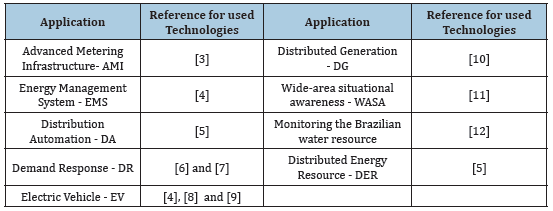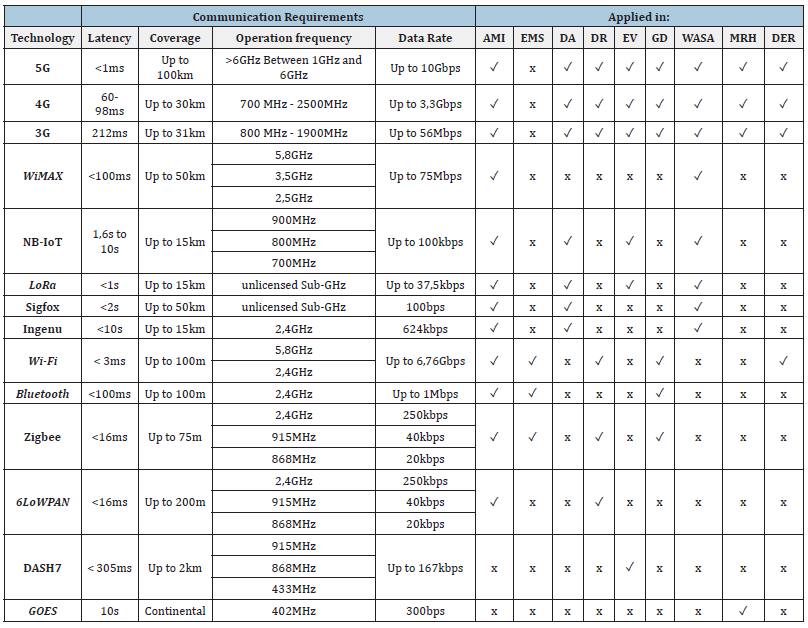- Submissions

Full Text
COJ Electronics & Communications
Analysis of the Use of 5G in Smart Grids Applications
Wélington Borsato Rodrigues, Alexandre Baratella Lugli and Benedito Donizeti Bonatto*
Associate Professor, Federal University of Itajubá, Brazil
*Corresponding author: Benedito Donizeti Bonatto, Associate Professor, IEEE Senior Member, UNIFEI - Federal, Federal University of Itajubá, Brazil
Submission: July 07, 2022;Published: April 19, 2023

ISSN 2640-9739Volume2 Issue4
Introduction
Choosing communication technologies for smart grids is not simple, because each application has its own communication requirements. For example, substation automation needs a latency of less than 200ms, but an electric vehicle charging monitoring can have a latency of minutes [1].
There is a diversity between the technologies already used in each solution, such as the use of cellular technology of different generations (2G, 3G, Long Term Evolution (LTE), also called 4G, Worldwide Interoperability for Microwave Access (WiMAX), among others). Several technologies standardized by the Institute of Electrical and Electronics Engineers (IEEE) are also used, such as the IEEE802 series standards (Bluetooth, Zigbee, etc.). In addition, wired technologies are used, such as Power Line Communication (PLC) and fiber optics [2] and there are also some promising technologies that are still underused, such as 5G [3-10].
Table 1 presents a compilation of references in which you can find which communication technologies are used in each smart grid application. In Table 2, you can find the references that cite the technical specifications of each technology [11-18].
Table 1:References to the technologies used in each application.

Table 2:References to the technical specifications of each technology.

Finally, Table 3 is the result of the compilation of the information obtained by the references presented in Table 1 & 2. Information on latency, coverage, operating frequency and data rate of technologies already used in the context of smart electrical networks is presented. In addition, a cross-referencing of information between technologies and applications was also carried out, according to the literature, where the “x” represents that the technology was not mentioned in the literature as applied to a particular application and the symbol “✓” demonstrates that there was quotes regarding your application [19-26].
Table 3:Compilation of technologies, technical characteristics and application.

In the line referring to 5G technology, the symbol “✓“ indicates in which applications 5G technology can be used [27].
All the analysis carried out showed that the use of 5G is coherent in most of the mentioned applications: In the advanced metering infrastructure, it is shown as a suitable technology mainly in WAN and NAN operations; In distribution automation, 5G meets all the requirements discussed; For demand response, 5G brings data bidirectionality and enables control and measurement of devices further away; For vehicular electrification [28-33], 5G allows monitoring of charging points, makes it even more possible to connect cars to the internet and creates new possibilities for V2G; In distributed generation, 5G facilitates the monitoring and maintenance of photovoltaic plants. For wide-area situational awareness, 5G meets range and latency requirements and will naturally be used, as cellular technologies are already part of this application. In water monitoring, 5G can optimize the off-grid systems of data collection platforms and increase the coverage area, but it does not prevent the existence of satellite systems, especially in the region in northern Brazil. For distributed energy resources, 5G comes as a promising technology for use in IEDs. The exception is with applications in which short-range technologies are more suitable, such as the energy management system, especially when applied to homes [33-35], buildings and data centers.
References
- Shelud'ko NS, Matusovskaya GG, Permyakova TV, Matusovsky OS (2004) Twitchin, a thick-filament protein from molluscan catch muscle, interacts with F-actin in a phosphorylation-dependent way. Arch Biochem Biophys 432(2): 269-277.
- Shelud'ko NS, Matusovsky OS, Permyakova TV, Matusovskaya GG (2007) Twitchin-actin linkage hypothesis for the catch mechanism in molluscan muscles: Evidence that twitchin interacts with myosin, myorod, and paramyosin core and affects properties of actomyosin. Arch Biochem Biophys 466(1): 125-135.
- Matusovsky OS, Shelud'ko NS, Permyakova TV, Zukowska M, Sobieszek A (2010) Catch muscle of bivalve molluscs contains myosin- and twitchin-associated protein kinase phosphorylating myorod. Biochim Biophys Acta 1804(4): 884-890.
- Matusovsky OS, Matusovskaya GG, Dyachuk VA, Shelud'ko NS (2011) Molluscan catch muscle myorod and its N-terminal peptide bind to F-actin and myosin in a phosphorylation-dependent manner. Arch Biochem Biophys 509(1): 59-65.
- Matusovsky OS, Mayans O, Szczesna-Cordary D (2015) Molecular mechanism of muscle contraction: New perspectives and ideas. Biomed Res Int 2015: 694345.
- Vyatchin IG, Shevchenko UV, Shelud'ko NS (2019) Protein composition of thick filaments from molluscan catch muscle and the role of twitchin in the catch-state formation. Biochem Biophys Res Commun 520(3): 634-639.
- Dobrzhanskaya AV, Vyatchin IG, Lazarev SS, Matusovsky OS, Shelud'ko NS (2012) Molluscan smooth catch muscle contains calponin but not caldesmon. J Muscle Res Cell Motil 34(1): 23-33.
- Lazarev SS, Shevchenko UV, Dyachuk VA, Vyatchin IG (2022) A preparative method for the Isolation of calponin from molluscan catch muscle. Int J Mol Sci 23(14): 7993.
- Vyatchin IG, Shevchenko UV, Lazarev SS, Matusovsky OS, Shelud'ko NS (2015) Troponin-like regulation in muscle thin filaments of the mussel crenomytilus grayanus (Bivalvia: Mytiloida). Biochim Biophys Acta 1854(10 Pt A): 1444-1450.
- Shelud'ko NS, Girich UV, Lazarev SS, Vyatchin IG (2016) Non-Straub type actin from molluscan catch muscle. Biochem Biophys Res Commun 474(2): 384-387.
© 2023 Benedito Donizeti Bonatto. This is an open access article distributed under the terms of the Creative Commons Attribution License , which permits unrestricted use, distribution, and build upon your work non-commercially.
 a Creative Commons Attribution 4.0 International License. Based on a work at www.crimsonpublishers.com.
Best viewed in
a Creative Commons Attribution 4.0 International License. Based on a work at www.crimsonpublishers.com.
Best viewed in 







.jpg)






























 Editorial Board Registrations
Editorial Board Registrations Submit your Article
Submit your Article Refer a Friend
Refer a Friend Advertise With Us
Advertise With Us
.jpg)






.jpg)














.bmp)
.jpg)
.png)
.jpg)










.jpg)






.png)

.png)



.png)






